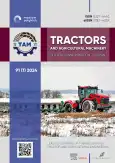Principles of adaptive control of roll stability of reconfigurable chassis with planetary-wheeled propulsion system
- Authors: Dobretsov R.Y.1,2, Kaninsky A.O.2, Popov D.S.1, Pryamitsyn I.B.1
-
Affiliations:
- Russian State Scientific Center for Robotics and Technical Cybernetics (RTC)
- Peter the Great St. Petersburg Polytechnic University
- Issue: Vol 91, No 1 (2024)
- Pages: 45-54
- Section: New machines and equipment
- URL: https://journals.rcsi.science/0321-4443/article/view/260269
- DOI: https://doi.org/10.17816/0321-4443-569204
- ID: 260269
Cite item
Abstract
BACKGROUND: Roll stability control is a relevant issue in transport platforms’ design in general. Well-known methods of roll stability control are used in development of vehicles of various types. However, these methods can not always be applied in design of small unmanned platforms, so development of special solutions is needed.
AIM: Justification of feasibility of application of anti-roll balancing mechanisms in small unmanned vehicles.
METHODS: The study is based on the analysis of technical solutions implemented in the design of platforms with extreme off-road capabilities and space rovers. Well-known methods of fundamentals of vehicle dynamics are the main tools of the study.
RESULTS: The options of roll stability control system for small unmanned platforms are described. The conclusions regarding feasibility of different options of balancing mechanisms for addressing the issue of counteraction of stability losing and overturning are made.
CONCLUSIONS: The discussed principles of roll stability control could be implemented in special small unmanned vehicles with any type of propulsion system. The further research in this field considers building of mathematical models capable of evaluating the required kinematics and power properties of the system of adaptive roll stability control, as well as testing using the mockup of a moving platform.
Full Text
##article.viewOnOriginalSite##About the authors
Roman Yu. Dobretsov
Russian State Scientific Center for Robotics and Technical Cybernetics (RTC); Peter the Great St. Petersburg Polytechnic University
Email: dr-idpo@yandex.ru
ORCID iD: 0000-0002-3827-0220
SPIN-code: 6168-3091
Dr. Sci. (Engineering), Professor of the Higher School of Transport
Russian Federation, Saint Petersburg; 29 Polytechnicheskaya street, 195251 Saint PetersburgAndrey O. Kaninsky
Peter the Great St. Petersburg Polytechnic University
Author for correspondence.
Email: kaninsky@yandex.ru
ORCID iD: 0000-0002-3057-1504
SPIN-code: 6057-7632
Postgraduate of the Higher School of Transport
Russian Federation, 29 Polytechnicheskaya street, 195251 Saint PetersburgDmitrii S. Popov
Russian State Scientific Center for Robotics and Technical Cybernetics (RTC)
Email: d.popov@rtc.ru
ORCID iD: 0000-0003-4575-9195
SPIN-code: 2474-9479
Head of the Design Bureau
Russian Federation, Saint PetersburgIgor B. Pryamitsyn
Russian State Scientific Center for Robotics and Technical Cybernetics (RTC)
Email: pib@rtc.ru
ORCID iD: 0009-0007-1085-3233
SPIN-code: 5769-7603
Head of Department
Russian Federation, Saint PetersburgReferences
- Ushiroda Y, Sawase K, Takahashi N, et al. Development of Super AYC. Technical review. 2003;15:73–76.
- Ghosh J, Tonoli A, Amati N. A torque vectoring strategy for improving the performance of a rear wheel drive electric vehicle. In: 2015 IEEE Vehicle Power and Propulsion Conference. Motnreal: IEEE, 2015. doi: 10.1109/VPPC.2015.7352887
- Forsyth RW, inventor; Lockheed Corp., assignee. Amphibious star-wheeled vehicle. United States Patent US 3348518 A. 1967 Oct 24. Cited: 09.09.2023. Available from: https://patentimages.storage.googleapis.com/7f/6e/fd/827d0492ed9502/US3348518.pdf
- Mamiti GI, Pliev SKh, Tedeev VB. Calculation of stability of a tricycle with a tilting body. Vestnik mashinostroeniya. 2015;7:30–34. (In Russ). EDN: WFAOPX
- Bao L, Dobretsov RYu, Voinash SA, et al. On the possibility of increasing the controllability and stability of movement of a wheeled vehicle by using controlled differentials. Transportnoe, gornoe i stroitelnoe mashinostroenie: nauka i proizvodstvo. 2023;19:84–91. (In Russ). EDN: UYIGMO doi: 10.26160/2658-3305-2023-19-84-91
- Dobretsov RYu, Porshnev GP. Car: turning, stability, cross-country ability. Saint Petersburg: Politekhn. un-t; 2011.
- Pavlov VV, Kuvshinov VV. Theory of motion of multi-purpose tracked and wheeled vehicles: textbook. for universities. Cheboksary: Cheboksarskaya tipografiya №1; 2011. (In Russ).
- Petrenko AM. Stability of special vehicles: textbook. allowance. Moscow: MADI; 2013. (In Russ).
- Chase R, Pandya A. A Review of Active Mechanical Driving Principles of Spherical Robots. Robotics. 2012;1(1):3–23. doi: 10.3390/robotics1010003
- Nosova NA, Galyshev VD, Volkov YuP, et al. Calculation and design of tracked vehicles: a textbook for universities. Leningrad: Mashinostroenie; 1972. (In Russ).
- Litvin FL. Gear theory. Moscow: Nauka; 1968. (In Russ).
- Taits BA, Markov NN. Precision and control of gears. Linigrad: Mashinostroenie; 1978. (In Russ).
Supplementary files












